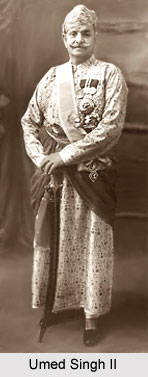 Umed Singh II was one of the most well known ruling Maharajas of the princely state of Kotah, which is currently in the Indian state of Rajasthan. He ruled over the territory from the year 1889 to 1940. Sir Umed Singh was born on 15th September 1873 and was a distant relative of Kishore Singh. At a young age, he was adopted by Shatru Sal II, Kaiser-i-Hind, who was the Maharaja of the state during that period. He successfully completed his education from the Mayo College in Ajmer. After the death of Shatru Sal II in the year 1889, Maharaja Umed Singh II, known as Udai Singh at the time, started an extensive and illustrious career as a soldier and statesman.
Umed Singh II was one of the most well known ruling Maharajas of the princely state of Kotah, which is currently in the Indian state of Rajasthan. He ruled over the territory from the year 1889 to 1940. Sir Umed Singh was born on 15th September 1873 and was a distant relative of Kishore Singh. At a young age, he was adopted by Shatru Sal II, Kaiser-i-Hind, who was the Maharaja of the state during that period. He successfully completed his education from the Mayo College in Ajmer. After the death of Shatru Sal II in the year 1889, Maharaja Umed Singh II, known as Udai Singh at the time, started an extensive and illustrious career as a soldier and statesman.
Even though Sir Umed Singh II was never appointed in any official position in the British Empire in India, he served as an advisor to chief government officials. He was sent his loyal army to fight for the British in both the World War I and World War II. Umed Singh II died at the age of 67 on 27 December 1940, after ruling over Kotah for a period of 52 years. He was succeeded by Bhim Singhji II, his son.
Titles of Umed Singh II
Maharaja Umed Singh II of Kotah held many titles through out his reign. These are mentioned below-
* Kunwar Sri Umed Singh (1873- 1889)
* His Highness Maharajadhiraj Maharaja Mahimahendra Maharao Raja Shri Umed Singh II Sahib Bahadur, Maharao Raja of Kotah (1889- 1900)
* His Highness Maharajadhiraj Maharaja Mahimahendra Maharao Raja Shri Sir Umed Singh II Sahib Bahadur, Maharao Raja of Kotah, KCSI (1900- 1903)
* Major His Highness Maharajadhiraj Maharaja Mahimahendra Maharao Raja Shri Sir Umed Singh II Sahib Bahadur, Maharao Raja of Kotah, KCSI (1903- 1907)
* Major His Highness Maharajadhiraj Maharaja Mahimahendra Maharao Raja Shri Sir Umed Singh II Sahib Bahadur, Maharao Raja of Kotah, GCIE, KCSI (1907- 1911)
* Major His Highness Maharajadhiraj Maharaja Mahimahendra Maharao Raja Shri Sir Umed Singh II Sahib Bahadur, Maharao Raja of Kotah, GCSI, GCIE (1911- 1915)
* Lieutenant-Colonel His Highness Maharajadhiraj Maharaja Mahimahendra Maharao Raja Shri Sir Umed Singh II Sahib Bahadur, Maharao Raja of Kotah, GCSI, GCIE (1915- 1918)
* Lieutenant-Colonel His Highness Maharajadhiraj Maharaja Mahimahendra Maharao Raja Shri Sir Umed Singh II Sahib Bahadur, Maharao Raja of Kotah, GCSI, GCIE, GBE (1918- 1939)
* Colonel His Highness Maharajadhiraj Maharaja Mahimahendra Maharao Raja Shri Sir Umed Singh II Sahib Bahadur, Maharao Raja of Kotah, GCSI, GCIE, GBE (1939- 1940)
Honours of Umed Singh II
Sir Umed Singh II, Maharaja of Kotahwas honoured several times, these are as follows-
* Delhi Durbar Gold Medal (1903)
* Knight Grand Commander of the Order of the Indian Empire- GCIE (1907)
* Delhi Durbar Gold Medal (1911)
* Knight Grand Commander of the Order of the Star of India- GCSI (1911), KCSI (1900)
* Knight Grand Cross of the Order of the British Empire- GBE (1918)
* King George V Silver Jubilee Medal, 1935
* King George VI Coronation Medal (1937)



















